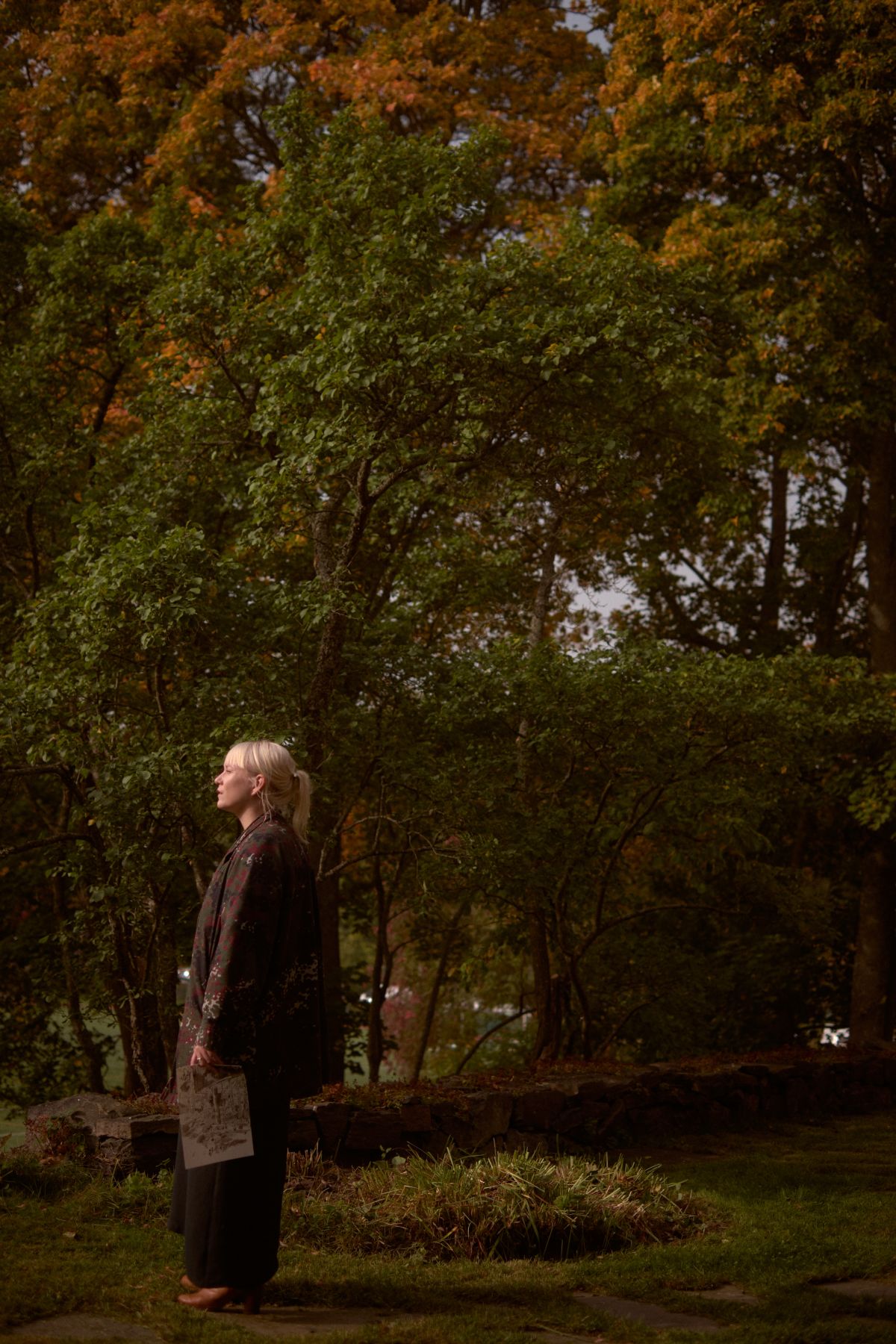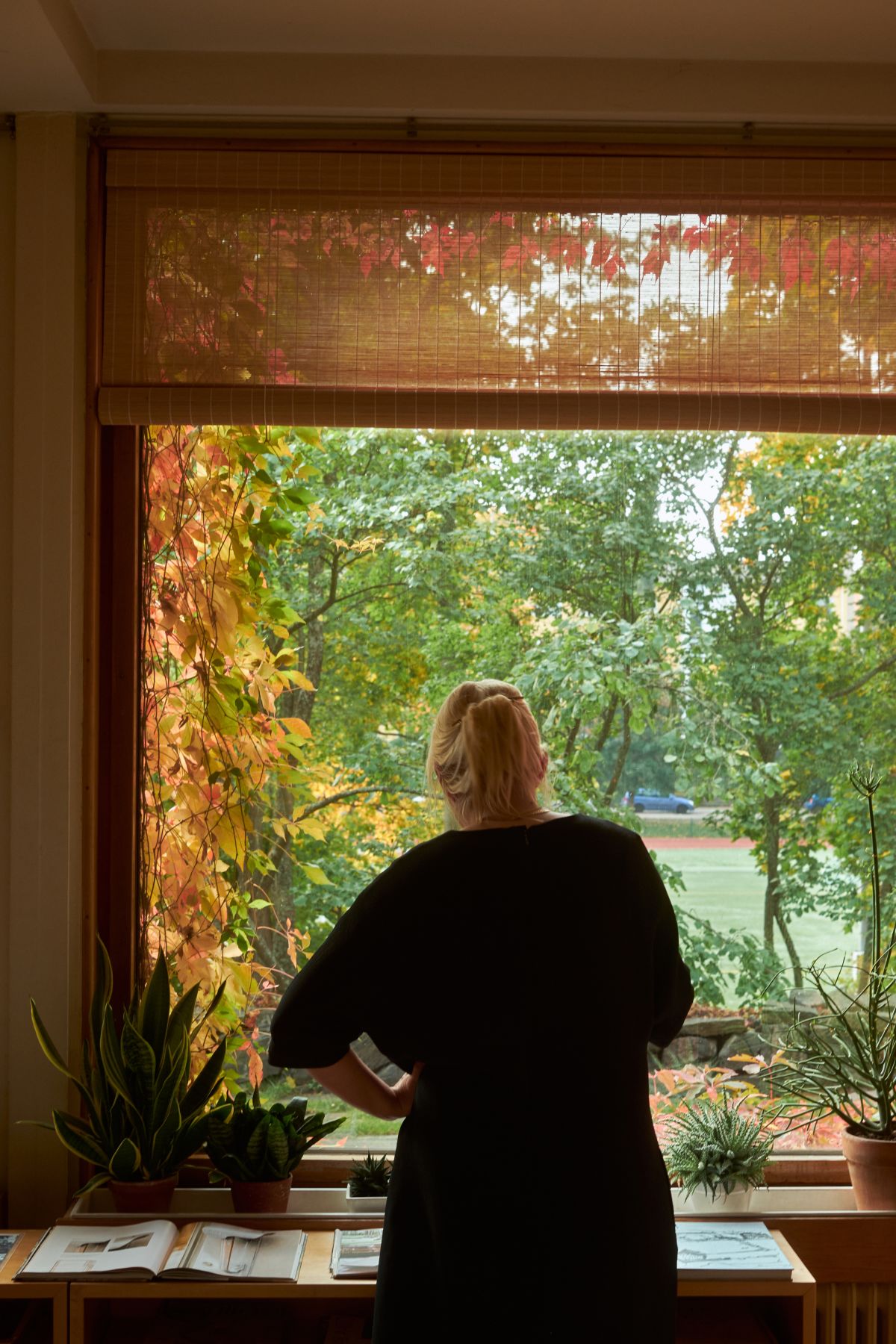
Garden as a Room
John Jervis in conversation with Karoliina Hellberg


It’s early. Karoliina Hellberg has a lunchtime appointment at a printer in Lahti, an hour north of Helsinki, where her new poster, Garden as a Room, commissioned to mark Artek’s 85th birthday, will be coming off the rollers. It’s a great fit between the talented Finnish artist, noted for her intense, multi-layered and often autobiographical paintings, and the pioneering design company. Artek has a long history of promoting contemporary art, having pledged to bring together different creative fields in its founding manifesto of 1935. Galerie Artek was launched a year later with a display of Moroccan rugs; cutting-edge exhibitions featuring Georges Braque, Pablo Picasso, Alexander Calder and Fernand Léger soon followed.
I meet with Karoliina – virtually of course – in her sunny studio in Vallila, a district that retains elements of its industrial past, so is peppered with creative spaces. Even better, it’s just 15 minutes from the centre of Helsinki by tram. Bundles of herbs hang on one wall – the studio, she tells me, is currently infused with the scent of eucalyptus – while two large canvases lean against the partition opposite, ready to accompany her on a forthcoming trip to Iceland. To avoid “the horror of white space”, both have already been primed with large blocks of colour: “I have no idea what those colours will become, or if they will even be visible when I finish.”
Given the freedom to approach the poster for Artek in her own way, she gravitated towards the Aalto House in Munkkiniemi, a calm neighbourhood north of Helsinki’s city center. Built and furnished by Aino and Alvar Aalto in 1936, it served as both their home and studio. I ask Karoliina why, of all the places associated with the pair, she was drawn to this unassuming dwelling.
KH: The Aalto House was just a wonderful place to visit. This was only the second time I’d been, and I found it immediately fascinating. It was mid-July, and the guided tour started in the garden, which was all green and lush, full of irises and peonies. The guide told us that the Aaltos always considered gardens to be part of an overarching architectural experience – they could be rooms in their own right. She also told all sorts of anecdotes about why the plants were chosen – it was clear there had been so much care and love and thought there. I started going by myself over and over, bicycling there with my papers and inks, doing sketches in the garden and trying to figure out what I found so compelling about it, and gradually it became clear that I’d found my subject.
JJ: I’ve seen some of those drawings – they’re lovely – what did you learn from all that sketching?
KH: For me, drawing is a way of looking. In the act of drawing, you get to a state where you’re able to really look at something, and begin to understand it differently. It gives me a sensation of learning something extra, even if it’s small or silly – the way the fence curves, or a little rock at its base – things you might not see at first. Drawing extends my experience of gathering information, and that’s how I approached this project – getting familiar with the space, learning about it, getting impulses from that act of looking. And, in the process, it became more personal. That’s one of the reasons why I kept going back to the Aalto House – it added another dimension. You end up with memories, even if they’re just from the previous day, you start to see changes, you feel a connection to that space.
JJ: Unusually for a modernist house, its interior is packed with textiles, furniture, lighting, plants, pictures, all the things that often fill your canvases – you weren’t drawn inside?
KH: I feel that there are important meanings and choices in how you make a garden, just as there are in interiors. At the Aalto House, the two didn’t feel like opposites – they’re very much connected, reflecting the same ideas and logic. The theme of spaces is a common factor in my work, whether they’re interiors or exteriors – both are made by people, both tell us something about who’s lived and worked there, and has thought about that space. Spaces provide a structure to get closer to a person, and to their story, even if they aren’t visible in the work itself. I felt that strongly in the garden. There’s a Japanese aesthetic expressed in it – for instance in the bamboo canes that shield the patio, or the stone paths – even though the Aaltos never visited the country in person, only in books. In my work, I often explore these sorts of imprints people leave on places, and the thoughts and meanings they embody.
JJ: So why did you shift your focus to the terrace, and to Aino Aalto’s planters?
KH: In the logic or the dramaturgy of a house, a terrace has something intrinsically interesting about it – what role does it play? If a garden can be considered another room, then what is a terrace? Does it have its own logic and rules? And there was something very moving about the space, maybe because of its rough materials – the concrete and stone. It felt personal, but also slightly hidden or secret. There were details that caught my eye – the wooden frame that Alvar Aalto used to exercise on, or those pots all filled with daisies, with paint that had started to peel off over time. There was a certain melancholy there.
JJ: Is that sense of the past, of melancholy, something you look for?
KH: I wouldn’t say that I’m only looking for sadness or melancholy – when I paint, I don’t feel like I’m aiming at any specific sensation – but it’s true that I do get easily interested in them. Sometimes it’s very hard to grasp why you get a feeling that something is important, whether a view or a person or a place or something you read. It might explain itself while you’re doing the work, or a bit afterwards, or you might never get an answer, but I try to cherish those things that engage me and, once I get a sense of motivation, I try and stay true to it – it’s one of the most essential things in my work.
JJ: Plants seem to crop up a lot in your paintings! Why’s that?
KH: It depends on the plant! They have a universal symbolism, which makes them a good tool, as well as possessing a sense of mystery and a strong visual appeal – they are never-endingly inspiring, because they work on so many levels. Plants can project a personal symbolism too, becoming a sort of unplanned language – they start to represent people or happenings or memories, becoming part of the story of the painting itself. A particular bouquet in an interior might reveal something about the person linked to that space, just as a textile or vase might, adding to a collage of elements that have their own significance for me, but will have implications for others too. I found it particularly meaningful that those daisies on the terrace at the Aalto House were also in the garden below. Someone had decided to move them there – there was a certain meaning, a purpose, to them.
JJ: Your practice is expansive, everything from canvases to ceramics – why did you choose watercolour this time round?
KH: I consider the watercolours to be paintings, just like the canvases, there isn’t a hierarchy, but there are some differences, even if they’re hard to define. There are parts of my practice that I like to nurture by not over-analysing them, letting them lead their own life, but I’ve noticed that I have a slightly different attitude towards paper. I feel more relaxed, it seems more straightforward, more friendly. It’s not that you always want your materials to be helpful, but paper is a good friend, and I cherish that. But my early drawings of the Aalto House were made on the spot – all my watercolours are done in the studio. I find that the studio is distinct from other spaces in one’s life – it has its own existence, its own sense of time, its own rules. Both thought and practice exist differently there: the gaze shifts, becoming more internal, relying more on memory, imagination and interpretation. And, in practical terms, the studio has been readied for these moments in the process when ideas and associations happen, when lessons learned while drawing on location are reworked and taken to a new place.
JJ: Do you feel that the work of Aino and Alvar Aalto still has a special resonance for Finnish culture?
KH: Yes, I think it has a very strong influence, and it’s not only their architecture. When you start looking around, you find their furniture everywhere – in our public buildings, schools or libraries, in our homes – places where we live, study and work. The more I’ve read about the histories and ideologies of the era when the founders of Artek – Aino and Alvar Aalto, Maire Gullichsen and Nils-Gustav Hahl – were all working together, the more I’ve appreciated that there was so much friendship and emotion there, and so many things that still resonate with Finnish ways of thinking, in particular around design, arts and technology. Artek’s manifesto emphasised how these disciplines can talk to each other, that they share an attitude about how you approach your work, how curious you are about the world, and what space means to you. And I guess that’s why I was drawn to the Aalto House. Every little thing there was given so much importance, everything happened for a reason – the design of the door handles, the placement of the plants or even the sticks that support them. I think this kind of a passion is part of the Aaltos’ legacy.




